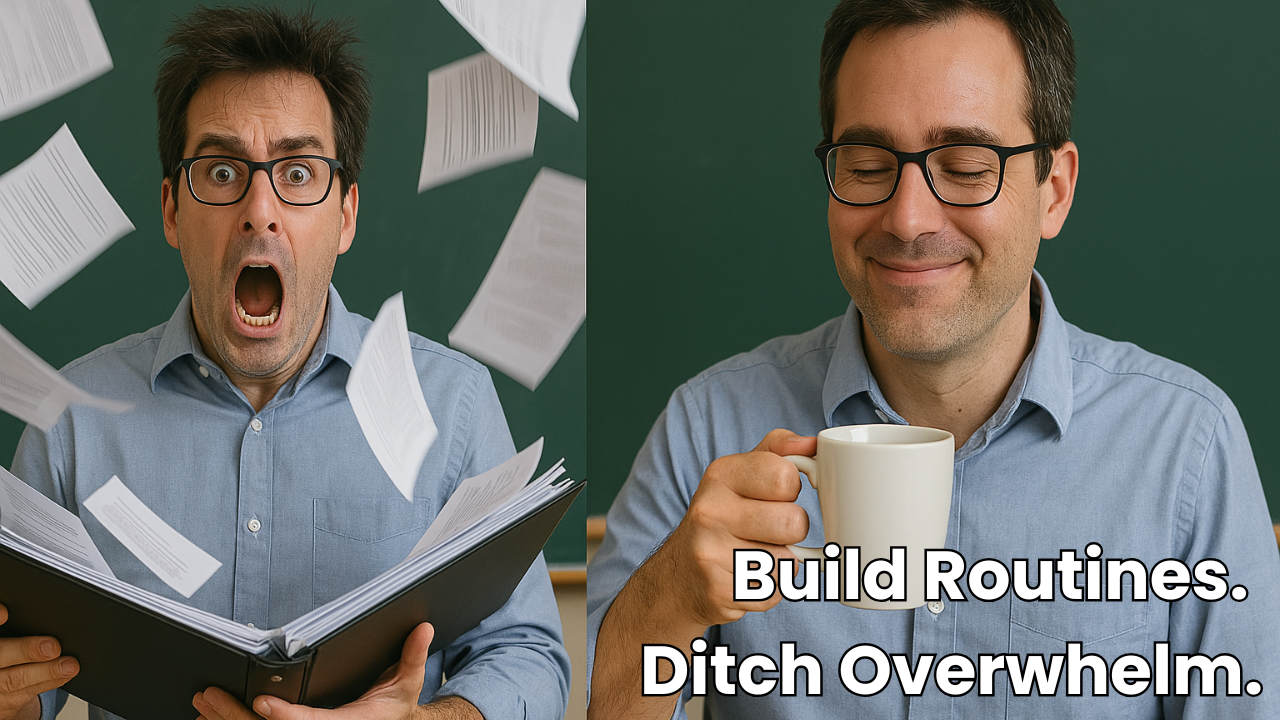
How to build routines that support language acquisition and reduce overwhelm
Introduction: From Chaos to CI Zen—Yes, It's Possible
So you’ve ditched the textbook. Congratulations! You’ve taken the first glorious leap into the world of Comprehensible Input. You’re free! Unburdened! Ready to inspire! And then… your students walk in.
One’s throwing a pencil like a javelin. Another’s trying to talk to you about her cat’s quinceañera (in English). You’re frantically projecting a “word cloud” about a flying llama, and everyone looks confused—including you.
This is the part where most CI-curious teachers panic. Because the truth is, just being engaging isn’t enough. You can’t CI your way out of classroom management. But routines? Routines are your anchor. Your lifeboat. Your very own instructional Xanax.
This article is your ultimate guide to establishing five foundational class routines that take the guesswork out of your day, keep your students on track, and—yes—actually support language acquisition.
And the best part? They’re quick wins you can start using tomorrow. No elaborate planning. No glitter glue. No tears (from you or your students).
Let’s bring in the calm. Let’s bring in the CI. Let’s build a classroom where everybody knows what to expect... and still laughs anyway.
Routine #1: The Predictable Launch—Same Start, Every Day
Imagine walking into your favorite coffee shop. You know where to stand. You know what to say. You know your barista will spell your name wrong. There’s comfort in the predictability.
Your students deserve that same feeling walking into your classroom.
The first few minutes of class should run like your favorite Netflix intro—comforting, familiar, and something students almost memorize. This reduces anxiety, boosts focus, and lets you maximize TL exposure right from the jump.
Here’s how to make it work:
Start with a greeting in the target language. Not a 20-minute speech—just a quick “Bonjour, mes amis!” or “¿Qué tal, clase?” Bonus points if you turn it into a call-and-response with gestures.
Follow it with a predictable visual cue. Project a daily slide with the day, date, weather, and a “feeling word” (emoji-based mood meter, anyone?). Students use gestures or point to a matching visual to respond.
Then jump into a 2-minute routine. Maybe it’s a “Question of the Day” they respond to silently or a quick “draw your mood” moment on mini whiteboards. The goal isn’t novelty—it’s building the neural pathway that says, “Ah yes, we are now speaking this language, and we are not panicking.”
The first five minutes are sacred. Protect them. Make them predictable. Make them peaceful.
Routine #2: Transitions That Don’t Make You Cry
Let’s talk about the part of class where all learning typically implodes: the transition.
You're vibing. They're vibing. Then you try to move from PictureTalk to a writing task and BAM—someone’s in the trash can, another’s doing parkour across desks, and no one remembers what language you’re even teaching.
But it doesn’t have to be that way.
Transitions can be calm, fast, and even input-rich when built into your daily routine.
Here’s how to make them magical (or at least manageable):
Use a target language signal to initiate every transition. Something short and fun like “¡Cambio!” or “On y va!” said with flair and a hand gesture. Train your class that this means go-time.
Add a physical cue. Have students stand up, stretch, and then sit down with their “next activity” posture. This resets their energy and gives their brain a micro-break.
Project a timer with a transition GIF. I’m talking 30 seconds of a sloth dancing or a llama moonwalking. Students see it and know: “By the time this llama finishes flossing, I’d better be ready with my notebook.”
Bonus: narrate the transition using input. “Clase, nosotros terminamos la historia… ahora, escribimos.” This keeps everything in bounds and builds listening skills while you manage bodies and materials.
Done consistently, these cues become habit. And when your students start responding to “Cambio” faster than Pavlov’s dogs? That’s the dream.
Routine #3: Comprehensible Input Anchors That Actually Anchor
Here’s the dirty little secret: You don’t need to reinvent the CI wheel every day. In fact, you shouldn’t.
The most successful CI teachers use routine input activities students can count on—like a weekly rhythm for the brain.
When students know what kind of input is coming (even if they don’t know the content), they’re more prepared to comprehend it.
Here’s how to build that into your week:
Use daily input themes. Monday = Weekend Chat. Tuesday = PictureTalk. Wednesday = Reading Day. Students love the structure (even if they pretend they don’t), and it cuts planning time dramatically.
Create anchor visuals. For PictureTalk, use a “talking frame” you point to with sentence starters in the TL. For story listening, have icons or color codes that show the type of phrase you're using.
Add a signature gesture or prop. When you pull out the red hat, they know it’s Story Time. When you start walking in slow motion, they know you’re narrating a chase scene. You don’t need Broadway skills—just commitment.
These routines don’t kill spontaneity—they make it possible. When the structure is clear, you can go wild within it. That’s where the magic lives.
Routine #4: Checking for Comprehension Without Killing the Vibe
Let’s face it—asking “¿Entienden?” gets you one of two responses: a sea of fake nods or total silence. Neither helps.
If you want to actually know whether students are understanding your input (and not just zoning out while daydreaming about pizza), you need to build check-in moments that are consistent, quick, and low-pressure.
Here’s how to make that happen:
Teach students a hand signal scale. Fist = totally lost. One finger = kind of confused. Five = I'm a linguistic ninja. Use it often and normalize every answer.
Use partner retells. Every few minutes, pause and say, “Tell your partner what just happened—but only using 5 words.” They laugh, they think, they clarify. And you listen in to check comprehension without a quiz in sight.
End class with a micro-exit chat. One student shares their favorite part of the lesson or answers a TL question as they walk out. It’s fast, it’s communicative, and it closes the loop.
Want to level it up? Make it a daily “retell battle.” Two volunteers stand up and retell the input. Class votes (with emojis) on whose was clearer or funnier.
These moments don’t just check understanding—they build it. Over time, students internalize meaning without even realizing it.
Routine #5: Engagement Isn’t Random—Make It a Habit
CI shouldn’t feel like you have to be the entertaining one 100% of the time. That’s how teachers burn out and end up narrating telenovela chase scenes with tears in their eyes and a cough drop stuck to their shirt.
Instead, build routine engagement roles and rituals that transfer some of the fun (and the workload) to the students.
Here’s how to build engagement into your class DNA:
Create classroom jobs. One student is the “Sound Effect Specialist.” Another is the “Facial Expression Coach.” Rotate them weekly. They love it. It builds community. It boosts participation.
Add a “mystery word” game to your daily routine. You choose a vocab word and use it 3-5 times sneakily during input. Students have to listen carefully and guess the word at the end. Bonus: Give a sticker or silly crown to the winner.
Use student-driven personalization rituals. Start the week by letting them vote on the class mascot of the week. “This week’s stories must feature… Señor Gato Loco.” They’re instantly bought in. Every character has meaning because they chose it.
Engagement doesn’t require confetti cannons. It requires buy-in. Make students the stars of your routines and suddenly... they’re actually excited for Spanish class.
Conclusion: Routines Are the Real Classroom Superpower
If your CI classroom feels like a three-ring circus right now, you’re not alone. Every teacher who ditches the textbook has a “What am I doing with my life?” moment during week one. But here’s the good news:
You’re not doing it wrong. You just need routines.
These five class habits are more than just “classroom management.” They’re scaffolds for acquisition. They reduce anxiety. They save your voice. They help you and your students feel confident, connected, and consistent.
So start small. Pick one routine and rock it. Then add another next week. And before you know it, your CI class is running smoother than a bilingual barista during finals week.
Want to see how ready you are for CI greatness? Take my free CI Proficiency Quiz to find your teacher type and get tips tailored to your journey.
Need a guided CI reboot to build these systems together? Join the Back-to-School Bootcamp—and start the year with routines that run themselves, a class that runs on laughter, and a teacher (you!) who runs on confidence.
🔑 Five Key Takeaways
- Predictable beginnings give students emotional and cognitive safety.
- Smooth transitions reduce chaos and increase time spent in the TL.
- Repeated CI routines reduce cognitive load and maximize input.
- Frequent, low-stakes comprehension checks build real understanding.
- Built-in engagement rituals boost buy-in without burning you out.



